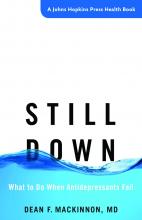“Still Down: What to Do When Antidepressants Fail” by Dean F. MacKinnon, MD, is a compact little book that recently was released by Johns Hopkins University Press. The title, “Still Down,” says it all. At 152 pages, the book is short, but not because it isn’t jammed full of information, but because – like the title – the writing is succinct and straight to the point; there’s no flowery detail, and Dr. MacKinnon doesn’t parse words. He tells the reader up front what his mission is, how the book is organized, and who his audience is. He’s an organized writer who captures the reader while getting his point across.
So how organized is Dr. MacKinnon? Each chapter is a clinical vignette, and the patients and doctors are given pseudonyms in alphabetical order: Ann sees Dr. Abernathy in chapter 1; then Bob sees Dr. Beasly in chapter 2. While “Still Down” is a series of nine short stories that make for a quick and interesting read, it provides enough information for a book twice the size. And in case the reader misses the point of the story (which is hard to imagine), each chapter ends with a summary of bullet points followed by case notes to clarify and expand on the points that were made during the vignette, and to add important commentary on the variety of decisions that might have been made for that particular patient’s story. Each chapter is short – a matter of pages, and there is no opportunity for the reader to get bored or tune out.The book is divided into three distinct parts. In chapter 1, Ann suffers from “textbook depression.” Dr. MacKinnon uses this as an opportunity to educate the reader on the signs and symptoms of major depression, and the fact that treatment takes several weeks, during which side effects may occur before the resolution of symptoms. He talks about depression as a recurring medical illness, lists the available antidepressants by their class, and mentions that depression can be a result of other medical illnesses such as thyroid disease. In chapter 2, college student Bob remains depressed until he takes the medications as prescribed at a steady dose on a daily basis. This involves some coaxing, education, and even outreach by the school nurse, all while being cognizant of things that can go wrong in a young person on antidepressants.
In chapter 3, Carla is a patient of both Dr. Cohen and Dr. Clark, and she is a sensitive soul who sees herself as beyond help. In addition, she has difficulty tolerating medications, and it is only with much support that she is able to get an antidepressant up to a therapeutic dose that gives her relief from her distress. In fact, Dr. Clark resorts to using an older tricyclic antidepressant so he can monitor levels, and he discovers that Carla’s levels run much higher than expected from the dose she’s on, explaining some of her sensitivity to medication and propensity to side effects.Part 2 of “Still Down” takes on the sticky issue of misdiagnosis. Darius sees Dr. Dennis for treatment of depression during a distressing period of his life when treatment with another doctor had already failed. After careful assessment, Dr. Dennis concludes that while antidepressants weren’t unreasonable to try, Darius is actually suffering from demoralization from losing his business, a miserable divorce, and a child custody battle. Dr. Dennis suggests therapy instead of medications at this point. This was where I found that, I, as a clinician, swayed from Dr. MacKinnon’s treatment approach: He emphasizes an inability to function and to feel pleasure as necessary elements of major depression, and Darius could do both to some extent. But still, his sleep was poor from shift work. He’d gained 30 pounds; he had little energy for activities besides work; and he was in a rut, unhappy, and having trouble entertaining his children when they visited and feeling too lazy to make changes. I thought Darius was depressed and demoralized, and while I agreed with the author that he needed psychotherapy, I also would have continued with medication trials. Dr. MacKinnon certainly doesn’t dismiss the idea of medication, and I found it helpful to revisit demoralization as a state responsible for many psychiatric symptoms.
Moving on in the section on misdiagnoses, the author talks about Evelyn, who turns out to have bipolar versus unipolar depression, and Frances, who carries an incorrect diagnosis of bipolar disorder, and has been overmedicated into a state of delirium. They both do well with time, thoughtful assessment, and treatment. Clinical pearls are threaded through these chapters.
“Depression-plus” is the title of the final section. Gary has major depression superimposed on his dysthymia, or persistent depressive disorder, and Dr. MacKinnon notes that people with constitutionally gloomy moods may have persistent sadness even after successful treatment of major depression. Here, there is a need for accommodation to a given personality state, and therapy can be helpful. Hannah, a patient of Dr. Hernandez, has what the author calls “depressed functioning.” This part I found most interesting, because I see this often in practice – a patient with a long history of being unmotivated and underfunctioning does not get fully (or any) better with antidepressants. Here, the functioning must improve before mood and self-esteem lift, and this is not an easy task. Finally, Irma has treatment-resistant depression, and with her doctor, considers a variety of augmentation medications as well as more novel strategies.
Simply stated, this book is a gem. It’s a very understandable guide to a very complex and frustrating issue, one that needs more time-consuming and thoughtful evaluation, and more intensive resources than a simple episode of depression usually entails.
Finally, I have to admit that I enjoyed Dr. MacKinnon’s quiet jabs at electronic medical records.
Dr. Miller is coauthor of “Committed: The Battle Over Involuntary Psychiatric Care” (Baltimore: Johns Hopkins University Press, 2016). She has known Dr. MacKinnon for many years.


